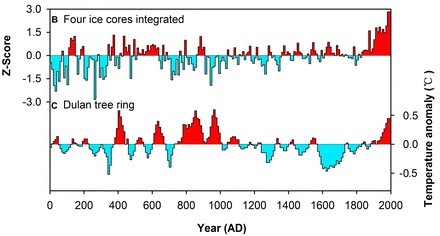Unprecedented warming is taking place at the Third Pole, the high-mountain region centered on the Tibetan Plateau that includes numerous glaciers and lakes. The region has nourished the local and downstream communities with fresh water for years as the "Asian Water Tower". "If abnormal climatic behaviors in this region are not properly examined, the odds are we will lose control of the consequences. Just imagine what a dysfunctional water tower will do to local communities." said Tandong Yao, lead author of a recent study investigating how abrupt and rapid warming has reshaped the environment of the Third Pole.
According to Yao and the international team who wrote the paper, the warming has been continuing in the last century, and soared higher than any time over the past two millennia in the last 30 years. Their conclusion is drawn from ice core and tree ring records, both bearing information about past temperatures.

Ice core and tree-ring climate records in the TP (Yao et al, 2019)
A closer look at the air temperature record reveals more peculiarities. The air in the region started to warm in the early 1950s, much earlier than in the broader Northern Hemisphere, where air temperature only began to rise in the mid-1970s. Even when both were warming, e.g., from 1955 to 1996, the warming rate at the Third Pole was much faster than in the Northern Hemisphere. The most dramatic temperature increase in Third Pole took place during the 1990s, when its neighboring area was actually cooling. Furthermore, the warming itself was not even, either temporally or spatially. The strongest warming occurred during winter, at a rate twice that of the annual average. In addition, warming is more pronounced in the Third Pole’s northern region than in its southern region.
With this bizarre temperature surge have come many environmental consequences. For starters, glaciers and snow melt. As the frozen water melts and changes the local water cycle, the hydrological balance of the region was disturbed. The disturbance, as reflected by expanded lakes and changing precipitation patterns, is then transmitted through atmospheric circulation to all of Asia and beyond. The picture becomes even more complex when researchers factor in the behavior of plants and aerosols as they both affect, and are affected by, this process."As the Third Pole becomes warmer and wetter, we see greener ecosystems and more frequent hazards", said Yao.
With more free water available, plants seem to be more robust in general. However, the hydrological imbalance also gives rise to more frequent disasters. In addition to landslides, debris flows, glacial lake outbursts, and snow and ice disasters, new disasters such as collapsing glaciers are also emerging. "Our next step will be investigating every major component of the Third Pole earth system for a fuller picture as to what could happen to this region in the future." said Yao.
The research was supported by the Strategic Priority Research Program (PAN-TPE) of the Chinese Academy of Sciences and National Natural Science Foundation of China. (Reported by XIA Cuihui)
Full-text available at https://journals.ametsoc.org/doi/10.1175/BAMS-D-17-0057.1


